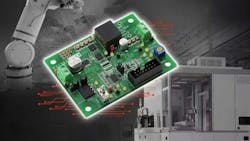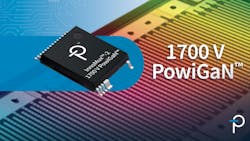2024 PowerBest Winners: Power Conversion and Management
What you’ll learn:
- Novel conversion architectures, used in conjunction with wide-bandgap devices, are being used to develop compact, cool-running onboard chargers for EVs that support vehicle-to-grid operation and fit automakers’ tight budgets.
- Advanced packaging technologies are combining with novel power-conversion architectures to offer extremely energy- and cost-efficient products for EVs, renewable power generation, and storage on other essential building blocks of the emerging green economy.
- The extreme demands of the power-hungry CPUs and GPUs that form the heart of modern servers and AI platforms require equally complex power-management devices to feed them.
TI GaN Power Stages and DC-DC Modules Push the Limits of Power Design and Density
Two new power-conversion device portfolios were unveiled by Texas Instruments: a family of gallium-nitride (GaN) power stages, and the industry’s smallest 1.5-W isolated DC-DC modules that enable designs with leading power densities and lower total cost.
Isolated DC-DC Modules
The UCC33420-Q1 and UCC33420 1.5-W isolated DC-DC modules with integrated transformers are the industry’s smallest and most power-dense devices, according to TI. They’re intended to help engineers shrink the isolated bias power-supply size in automotive and industrial systems by over 89%.
The new modules use TI’s next-generation integrated transformer technology, which eliminates the need for an external transformer in a bias supply design. The technology makes it possible to shrink solution size by more than 89% and reduce height by up to 75%, while cutting bill of materials by half compared to discrete solutions.
GaN Power Stages
The 100-V integrated GaN LMG2100R044 and LMG3100R017 power stages feature thermally enhanced, dual-side cooled package technology to simplify thermal designs and achieve the highest power density in mid-voltage applications. It can reduce solution size by 40% or more. Boasting a power density of 1.5 kW/in.3, their lower output capacitance and gate-drive losses can deliver up to 50% lower switching losses than a comparable silicon-based design.
Originally appeared in the March 2024 edition of PowerBites
ROHM Hybrid Power-Supply Architecture Leverages Analog-Digital Fusion
As seen in the July edition of PowerBites, ROHM Semiconductor’s LogiCoA hybrid power-supply architecture delivers the superior precision and functionality of digitally controlled supplies to low- and medium-power industrial and consumer applications. It also offers efficiencies and solution costs equivalent to all-analog designs.
Capable of supporting designs ranging from 30 W to 1 kW, applications include semiconductor manufacturing equipment, gaming systems, and a wide range of other industrial equipment and consumer products.
LogiCoA’s “analog-digital fusion control” combines a digital control block centered around a specialized low-power MCU with analog circuitry comprised of silicon MOSFETs and other power devices. This hybrid approach supports a number of versatile features, such as a built-in three-channel analog comparator that can be linked to a timer and a digital-to-analog converter that enables digital control of various parameters to support different power-supply topologies.
In addition, both control parameters (such as current and voltage values) and operation log data can be recorded in the MCU's nonvolatile memory.
Originally appeared in the July 2024 edition of PowerBites
Power Integrations 1700-V Multi-Output Switcher Uses GaN to Deliver SiC-Level Efficiency and Performance
Power Integrations’ introduction of the industry’s first commercial gallium-nitride (GaN) power-conversion devices rated for 1,700 V marks yet another incursion on markets that, until now, were best served by products fabricated in silicon carbide (SiC).
Available with up to three independently regulated outputs, the 1700-V InnoMux-2 single-stage, offline power-supply ICs can be used with input voltages of in excess of 1,200 V DC. They feature the high levels of reliability required in automotive chargers, solar inverters, three-phase meters, and many other types of industrial power systems.
The InnoMux-2 IC leverages PI’s FluxLink secondary-side regulation (SSR), digital isolation communications technology, paired with its patented multiplexing technique, to precisely monitor and control the power being fed to each of the converter’s switching outputs. This enables the converter to support zero-voltage-switching (ZVS) operation that virtually eliminates switching losses.
The device’s single-stage conversion architecture also eradicates the losses incurred by StackFET circuits and other earlier technologies typically used to achieve operating voltages in excess of 750 to 1,000 V.
Originally appeared March 28, 2024
AOS 3-Rail, 7-Phase Power Controller for Computing Systems Features Low Iq
Alpha and Omega Semiconductor Limited's (AOS) AOZ71137QI is a 3-rail, 7-phase controller intended to serve as a multiphase core voltage (Vcore) power-management system. Delivering extremely low quiescent power (Iq), the AOZ71137 is designed to meet Intel IMVP 8, 9, 9.1, and 9.2 specifications.
When paired with AOS’s benchmark DrMOS and Smart Power Stage (SPS), this combination of devices provides a complete power-delivery solution for Intel Meteor Lake and Arrow Lake notebook platforms.
The AOZ71137 digital controller is designed with AOS’s Advanced Transient Modulator (A2TM), an advanced variable-frequency, hysteretic, peak current-mode control with a proprietary phase-current-sensing scheme. With the control provided by the A2TM feature, designers can implement fast transient response and optimal current balance for both transient and DC load.
In addition, the controller provides complete protection and warning features, including UVP, OVP, OCP, and OTP. Fault-protection behavior can also be easily programmed through SMBus. AOS’s Vcore solution offers real-time telemetry information via its SMBus for VIN, VOUT, temperature, output currents, power states, and PSYS/VSYS /IAUX pins reporting through the SMBus.
Originally appeared in the July 2024 edition of PowerBites







